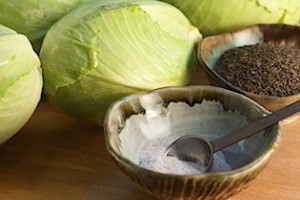Did you know that 80% of your immune system is located in the digestive tract? Since that’s the case, it’s essential to keep those pipes healthy, especially during the fall and winter months, when we can be more susceptible to contracting illnesses. So what to do, you ask?
One of nature’s most effective ways to boost immunity is to build good gut health by eating Fermented Foods and by supplementing with probiotics.
It’s important to have an abundance of friendly bacteria in our gut to keep the harmful bacteria, infections, and other invaders at bay.
Eating a diet rich in fermented foods will help feed the beneficial probiotic bacteria that populate our large intestine. These microflora do crucial jobs like detoxify environmental chemicals, metabolize hormones, and manufacture vitamins. They are also able to combat infectious microbes, ease allergic response, reduce inflammation, improve digestion, and ward off cancer.
In a recent study of children aged 3-6 attending daycare or schools in the Washington, D.C. area, kids were randomly selected to take a probiotic-rich fermented drink or a placebo to test the efficacy of reducing childhood illness like colds and flu. The study showed a 19% lower incidence of infectious disease in those in the fermented drink group.
Old school fermented foods like sauerkraut and miso have been staples to people throughout the world for eons and for a good reason. There is a movement to bring these traditional medicinal foods back, so start looking around for them at farmer’s markets and grocery stores.
I’m grateful to the people that are keeping these important ways of eating alive, so future generations will have the tools and skills needed to create proper digestion and good health for themselves and their families.
Below you’ll find how easy, tasty, and varied these special healing immune-boosting foods can be.
Favorite Fermented Foods
Sauerkraut
Sauerkraut is fermented cabbage and probably the more well known of the fermented foods. Not only does sauerkraut invigorate a sandwich (or a hot dog (um, no…), it is also rich in nutrients including vitamins C, the B’s, particularly B12, and digestive enzymes.
Cruciferous vegetables, like those in the cabbage family, are also high in indoles that help balance and clear excess hormones. Sauerkraut is also beneficial in treating candida and balancing out the body’s pH.
DIY Sauerkraut is very easy to make, taking 1-4 weeks to ferment, and depending on your tastes. All you need is a large crock, cabbage and sea salt. Fermenting veggies like cabbage is also a great way to preserve them quite cheaply, easily, and naturally. If you do forgo the homesteading method and decide to purchase kraut, remember that it is best to buy it unpasteurized so as to retain the live bacteria.
Check out our local Santa Cruz Sauerkraut purveyors at Farm House Culture.
Or visit counter-culture icon Sandor Ellix Katz, author of Wild Fermentation for more inspiration and recipes.
Kimchee
The first time I tried kimchee was at a Chinese restaurant. It was odd because kimchee is a traditional fermented Korean food. I immediately liked it. Kimchee is a hot, spicy, tangy dish made with cabbage, red pepper flakes, garlic, ginger, and salt known to be one of the top 5 healthiest dishes in the world.
Its high concentration of probiotics, essential vitamins, and minerals is known to ward off infections, lower LDL cholesterol, improve digestion, and thwart cancer growth.
Kefir
Kefir is a fermented milk drink that contains live cultures and forms a multitude of microflora, amino acids, enzymes, vitamins, and minerals like calcium, magnesium, and phosphorus. These vital nutrients work to strengthen the immune system in particular, by supporting the digestive tract.
The health claims for kefir go on and on. A few of the biggies include ~ treating metabolic syndrome, poor digestion, chronic fatigue, nervous system disorders, heart disease, and cancer. Kefir acts as an antibiotic and an antifungal by building friendly flora in the large intestine. We know that certain strains of the microflora in kefir can kill candida albicans.
DIY Make your own kefir. All you need is to obtain a kefir culture. Start by placing this culture starter in a clean glass jar and filling 2/3 full with milk. Depending on the temperature and your taste preferences, kefir will take between 12-48 hours to ferment. The kefir also will ferment faster in warmer temperatures. You can later add fruits and different flavors to your liking after your kefir is done fermenting.
Tempeh
Tempeh is a fermented soybean food that has been a staple in Indonesia for centuries. It is gaining popularity around the world, especially as an excellent complete protein food for vegetarians and vegans. It also provides an abundant supply of B-12 that is often hard for vegans and vegetarians to get in sufficient amounts.
Tempeh is delicious sliced, cubed or crumbled and then pan-fried in coconut oil. It’s delicious added to stews or over veggies and rice.
DIY Tempeh is quite simple to make at home, so the tempeh folks say!!
Basically: Split de-hulled soybeans in half, soak overnight, then cook for 1 hour. Mix in tempeh starter made from the spores of Rhizopus oligosporus or Rhizopus oryzae. Store in a dark 88-degree space, and you’ll have fresh tempeh in just 36-48 hours.
For more information on how to make tempeh go to Tempeh. Info or look for a copy of the tempeh bible, The Book of Tempeh, 160 pages, by William Shurtleff and Akiko Aoyagi.
Have fun, and enjoy the health benefits of making and eating fermented foods. Please share with us your experiences making fermented foods. We want to hear from you.

